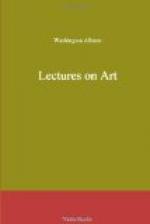is also a moral intelligence, and that they together
form the man. This important truism (we say important,
for it seems to have been not seldom overlooked) makes
the foundation of all his future observations; nor
can he advance a step without continual reference
to this double nature. We find him accordingly
in the daily habit of mentally distinguishing this
person from that, as a moral being, and of assigning
to each a separate character; and this not voluntarily,
but simply because he cannot avoid it. Yet, by
what does he presume to judge of strangers? He
will probably answer, By their general exterior.
And what is the inference? There can be but one;
namely, that there must be—at least to
him—some efficient correspondence between
the physical and the moral. This is so plain,
that the wonder is, how it ever came to be doubted.
Nor is it directly denied, except by those who from
habitual disgust reject the guesswork of the various
pretenders to scientific systems; yet even these, no
less than others, do practically admit it in their
common intercourse with the world. And it cannot
be otherwise; for what the Creator has joined must
have some affinity, although the palpable signs may
elude our cognizance. And that they do elude
it, except perhaps in a very slight degree, is actually
the case, as is well proved by the signal failure of
all attempts to reduce them to a science; for neither
diagram nor axiom has ever yet corrected an instinctive
impression. But man does not live by science;
he feels, acts, and judges right in a thousand things
without the consciousness of any rule by which he so
feels, acts, or judges. And, happily for him,
he has a surer guide than human science in that unknown
Power within him,—without which he had been
without knowledge. But of this we shall have
occasion to speak again in another part of our discourse.
Though the medium through which the soul acts be,
as we have said, elusive to the senses,—in
so far as to be irreducible to any distinct form,—it
is not therefore the less real, as every one may verify
by his own experience; and, though seemingly invisible,
it must nevertheless, constituted as we are, act through
the physical, and a physical medium expressly constructed
for its peculiar action; nay, it does this continually,
without our confounding for a moment the soul with
its instrument. Who can look into the human eye,
and doubt of an influence not of the body? The
form and color leave but a momentary impression, or,
if we remember them, it is only as we remember the
glass through which we have read the dark problems
of the sky. But in this mysterious organ we see
not even the signs of its mystery. We see, in
truth, nothing; for what is there has neither form,
nor symbol, nor any thing reducible to a sensuous
distinctness; and yet who can look into it, and not
be conscious of a real though invisible presence?
In the eye of a brute, we see only a part of the animal;
it gives us little beyond the palpable outward; at




